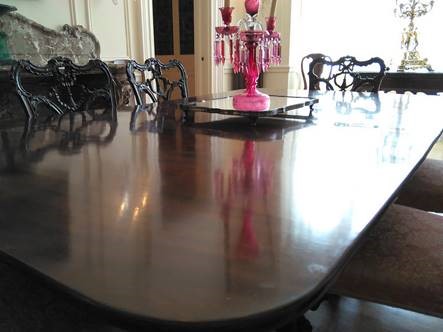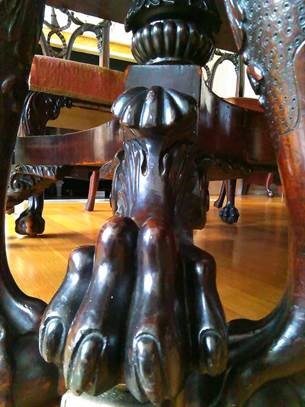This blog post was written by Andrew White
Dealers and collectors in rare and lovely things, the founding brothers of the Rosenbach had a profound connection to their Jewish heritage—reflected particularly in the collecting and scholarly pursuits of the younger brother, Dr. Abraham Rosenbach. Dr. Rosenbach was president of the New York Jewish Historical Society from 1921 to 1948, and wrote a bibliography of American Judaica that was the chief resource for scholars of that subject for many years. As Rosh Hashanah is celebrated this week, my thoughts found their way to the Rosenbachs’ magnificent dining room table, which echoes with stories of Abraham and older brother Philip entertaining their well-heeled collector clients, as well as stories of family gatherings through the years that the brothers lived with their sisters Rebecca and Miriam. Until 1926, when both sisters died of the influenza, the brothers—according to Abe’s biography—“made every effort to be home for the Sabbath.”

The elegant table seen above would have been part of the brothers’ Sabbath celebration at their 2006 Delancey home, as well as during their tenure at 2010 Delancey where the table currently resides. The Rosenbach biography paints a warm picture of the brothers’ faithfulness to Jewish tradition in their home life, sitting down to Friday dinner “with bowler hats covering their heads… and reciting the Sabbath service at their elegantly set table.” Evoked as customs remembered from the childhood of the Rosenbach siblings, and observed throughout their adult lives, the biography goes on to describe “the kindling of the lights, the blessings of the bread and wine, and the chanting of the traditional Hebrew prayers…” Although the brothers did not keep kosher at their shops or at their Corson’s Inlet shore house, the biography cites the wishes of their sisters as a partial reason for doing so at home, along with Phillip’s “fulfillment of his role as a patriarch, the head of a Jewish family,” and Abe’s “renewal of the praise his mother had bestowed on him when he first learned the Hebrew words of the service by heart.” The brothers’ sense of their identities, their heritage, and their love for family, present and departed, were all embodied within these Sabbath observances on Delancey Place.
But the Rosenbach dining table’s story doesn’t start there. One object can have many tales, and a collector’s home fills with tales as it fills with objects—tales that may echo one another in surprising and poignant ways. The Rosenbach brothers were first-generation Americans, the sons of an immigrant father, so it’s perhaps not surprising that their house is filled with stories of immigrants, sojourners, and exiles. Historical figures in the museum’s portrait collection—like Michael Gratz, Fanny Kemble, and Steven Girard—embody this theme, just as the wandering Leopold Bloom and the Ingenious Nobleman Mister Quixote of La Mancha do in the museum’s holdings of first editions and manuscripts. Fittingly, another name that can be added to this list of voyagers is that of Antoine Quervelle, the probable maker of the Rosenbachs’ lovely dining table.
Antoine Quervelle was born in Paris, and became a US citizen in 1823, settling in Philadelphia. Give or take a decade, he would have made what became the Rosenbachs’ dining table around 1830. As a maker of fine furniture, Quervelle entered his creations into competitions at the Franklin Institute, and became so successful that in 1829 he received a commission to build four pier tables and three center tables for the East Room of the White House. This presidential connection would have made a Quervelle table a prized possession for Phillip Rosenbach—as a dealer and collector of art and fine furnishings with a soft spot for objects with noble pedigrees. Having relatives in the White House also made the Quervelle table a fitting companion to other Rosenbach furnishings, with their Buonaparte, Stuart, and Hanoverian associations.
Filed at Philadelphia’s city hall on his death, an inventory of Quervelle’s worldly possessions included engravings of Napoleon—suggesting that the fortunes of France continued to be a matter of interest and pride to him throughout his life as a U.S. citizen. Like the Rosenbach family history, Antoine Quervelle’s story is one of an immigrant who did well in his adopted country while retaining connection to his culture of origin. The Rosenbach is filled with tales of immigrants or transplants who made significant contributions to the life of their adopted nation—starting with the Rosenbachs themselves, and including the real-life patriots on the Rosenbach’s walls and their fictional counterparts in the Rosenbach library. These tales are entertaining to trace throughout 2010 Delancey Place, as well as significant, or even essential to our culture’s identity, history, and future.
Shanah Tovah!

Source: Wolf, Edwin II, 1960. Rosenbach: A Biography.
Further reading: The Philadelphia Museum of Art has a Quervelle secretary bookcase and sofa, check them out here; the Metropolitan Museum in New York has this lovely Quervelle center table.
